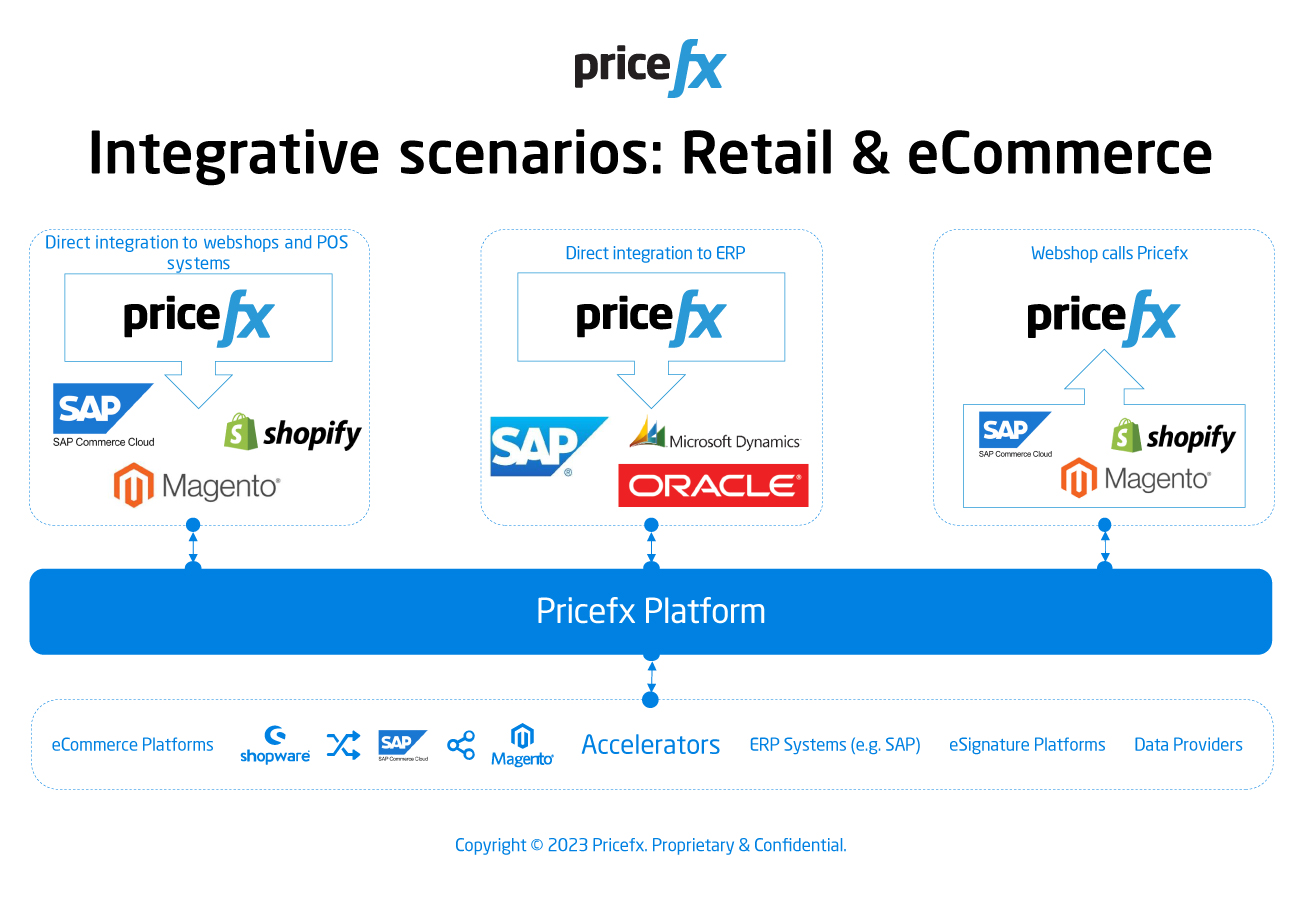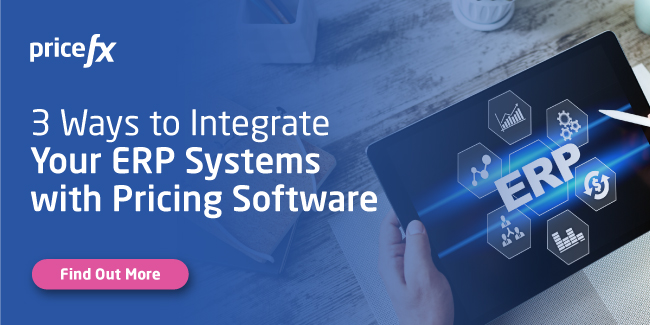Webshop-Pricing System Integration Methods: Which to Choose?
September 28th, 2023 (Updated 11/24/2023) | 7 min. read
So, you’ve run the numbers through your pricing strategy for the next pricing period – great! Problem is, in retail and e-commerce, those prices aren’t worth much if they can’t be translated into a format your webshops understand, and this is where integration methods become important.
Here at Pricefx, as a leading cloud-native pricing software company with retail among the key industries we serve, we understand that in retail and e-commerce, choosing the right webshop integration method plays a vital role in ensuring optimal customer experiences online and scalable adaptation to fluctuating market dynamics.
To help, we break down each of the most common webshops integration methods with pricing software, including their strong and weak points, so your company can choose the approach that best fits its business needs.
So, let’s dive in.
Most Common Webshop Integration Methods, Explained and Compared

1. Direct Integration to Webshops
A direct integration to webshops scenario involves connecting a company’s pricing system directly to an online store. With this approach, prices are calculated in the pricing platform, such as Pricefx, and sent to the website to be automatically reflected in the online retail environment.
Benefits of Direct Integration to Webshops
Real-Time Price Updates
The real-time price updates enabled by a direct integration to webshops not only allows for a seamless user experience, as customers can witness accurate prices without delays, but also supports a smoother implementation of pricing strategies that require minute-by-minute price adjustments.
Less Manual Intervention
With direct webshop integration, prices in the online retail platform are automatically synchronized with those in the pricing software solution, minimizing the need for manual intervention to review discrepancies and modify prices. In turn, this lessens the burden on pricing teams to intervene and frees up their time to focus on more strategic initiatives.
Drawbacks of Direct Integration to Webshops
Manual Overrides in Other Systems
When online stores serve as the source of truth for pricing, some sales activity that is normally carried out in traditional systems, such as ERP, are manually overridden as a result. For example, as it contains the most up-to-date prices, the webshop itself initiates the sales order process, while the ERP system handles the subsequent processes such as delivery.
Under a dynamic pricing system with rapid price fluctuations, overrides like these are constantly triggered, requiring affected systems to keep up the pace.
Data Scalability Issues
Web shops are not infinity scalable in the amount of pricing data the system can hold at once; a website’s performance could be compromised once the number of SKUs and price adjustments needed exceeds its operational capacity.
So, while businesses with 5+ million SKUs may find integrating directly with webshops logistically challenging, those with smaller product assortments or fewer affected systems could benefit from this approach.
2. Direct Integration to ERP
A direct integration to ERP scenario involves connecting a pricing system directly to a company’s Enterprise Resource Planning (ERP) system, such as SAP or Oracle, or any kind of middleware or management system for channels or products.
Benefits of Direct Integration to ERP
Robust Pricing Conditions
The complex conditional pricing rules coming from a pricing software solution are easily digestible for ERP solutions, which enables the seamless implementation of dynamic pricing, value-based pricing, or any pricing strategy that considers a vast number of pricing variables.
Here, the pricing system does most of the heavy lifting in price calculations before passing on the raw data file to the ERP system, which then layers its own conditions on top, such as promotions, to calculate the final sales price.
Centralized and Secure Pricing
As the heart of many companies’ business operations, the ERP system provides a centralized mechanism for pricing that supports more consistent pricing across systems. What’s more, by doing away with the need for intermediary applications, a direct integration with ERP method introduces another layer of data security that businesses working regularly with sensitive data require.
Drawbacks of Direct Integration to ERP
Potential Performance Issues on Online Channels
A company opting for direct pricing software to ERP integration may face certain challenges in its online retail or e-commerce channels, as the time needed for up-to-date prices to load on a web page from an ERP system may be longer than the average user is used to.
So, while direct integration to ERP is a well-established and reliable approach, it may come at the expense of website performance.
3. Webshop Calling Pricing Software Provider
A webshop calling pricing software provider scenario is when a webshop platform API calls the provider, such as Pricefx, to request real-time pricing information based on specific parameters like market and order date. To do this, the pricing software solution will need to calculate the sales prices at the point of the request, incorporating all pricing conditions, including any promotions running at the time.
This scenario is the most modern of the integration approaches, and many companies are in the process of building their internal architecture to be API-first.
Benefits of Webshop Calling Pricefx
Real-Time Price Updates
Like direct webshop integration, a webshop can use API-based integration to retrieve up-to-date pricing information in real time, which ensures customers have access to accurate pricing when they need it and have trust in the purchasing process.
Minimal Data Redundancy
Because the calculation complexity of strategies like dynamic pricing is outsourced to the pricing software solution, other systems only need to house the pricing information they explicitly request, which offloads unnecessary data and keeps redundancy to a minimum.
Drawbacks of Webshop Calling Pricefx
API Performance Issues
In API-first integrations, pricing retrieval on webshops is delayed when the API is unresponsive or misconfigured. This puts businesses at a financial loss when customers are ready to make a purchase, for example, on Amazon, and they can no longer buy the items in their cart due to disappearing prices.
Which Webshop Integration Approach Is Right for My Business?
For most businesses, the right integration method comes down to their existing technological stack, the breadth of their product assortment and sales channels, their data security needs, and a whole host of other considerations that make certain methods more realistic than others.
For example, companies that require dynamic price adjustments would benefit from the real-time pricing retrieval capabilities that direct webshop or API integrations provide. On the other hand, those working in industries with highly sensitive data, or where rapid price adjustments aren’t required, may find a direct ERP integration approach to be the better choice.
Your company should evaluate the impact of each integration approach on key areas like price performance, data scalability, and overall customer experience, as well as consider their compatibility with organizational policies or politics.
Ultimately, with Pricefx, your choice of integration method isn’t confined to what the platform is able to support. Because our modern architecture enables any of these integration methods, your business can confidently select the method that genuinely suits its needs without limitations.
Next Up: How to Integrate Your ERP Systems With Pricing Software
In this article, we covered the most common ways to integrate pricing software with webshop channels, including their benefits and drawbacks, to empower businesses to make well-informed integration decisions moving forward.
If your company is just starting out on its pricing software implementation journey, considering how ERP systems integrate with pricing software is another great place to start. To learn more, check out our comprehensive article below:
